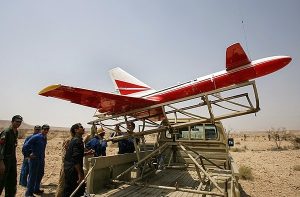Catherine Putz

Last week, Ukrainian journalist Dmitry Gordon commented during a discussion with Russian-born Israeli businessman Leonid Nevzlin that Iran manufactured drones in Uzbekistan. The comment triggered a swift retort from Tashkent, which denied the report and urged Ukraine to “take appropriate measures” to prevent media from spreading “unfounded accusations.”
In writing about the kerfuffle, I noted that Gordon probably misspoke, confusing Uzbekistan with Tajikistan. Tajikistan, after all, does have an arrangement with Iran to produce drones. In May, Iran’s Major General Mohammad Bagheri, the chief of staff of the Iranian Armed Forces, traveled to Dushanbe to meet with President Emomali Rahmon and senior military officials, and inaugurate a drone factory.
On October 28, Gordon clarified that he’d meant to say “Tajikistan.”
And yet, the devil is still in the details.
On October 30, the Tajik Ministry of Foreign Affairs refuted Gordon’s claims that Tajikistan produced drones used to kill Ukrainians. “We emphasize that the Republic of Tajikistan does not export military equipment to third countries,” the statement noted.
According to government statements and press releases from May, the drone factory inaugurated by Iranian and Tajik officials earlier this year is specifically for Ababil-2 drones.
The Ababil is a relatively cheap, older family of single-engine multirole tactical unmanned aerial vehicles (UAVs, colloquially referred to as “drones.”) The Ababil-2 was developed in the 1990s and has been described by analysts as “a cheap, easy-to-use, and flexible drone.” The Ababil-2 has a length of 2.88 meters and a wingspan of 3.25 meters. Its maximum speed is 370 k/hour and it has a combat range is 120 kilometers.
The drones terrorizing Ukraine are not Ababil-2s but Shahed-136 “suicide drones.” Ukrainian forces have also reported shooting down a Mohajer-6.ADVERTISEMENT
The Shahed-136 is a relatively new model employed by Russian forces under the name Geran-2. It is larger and slower than the Ababil-2, with a maximum reported speed of 185 k/hour, but with a much longer range, estimated at between 1,800 and 2,500 kilometers.
The Ababil-2 and Shahed-136 are visually quite different. If the former had been spotted in Ukraine it would have been reported by now. Importantly, Russia does not operate Ababil-2 drones.
With the drone factory in Tajikistan inaugurated only in May of this year, it’s unclear if the facility has produced any drones yet. More importantly, when it does, those drones are intended for the Tajik military and not for export. Kyrgyzstan reportedly deployed a recently acquired Turkish drone during the escalation of conflict on the Kyrgyz-Tajik border in September. If Tajik-produced Iranian drones are going to be seen anywhere, it’s going to be over the Kyrgyz-Tajik border — not in Ukraine.
A report Tajik authorities did not refute, however, was one that claimed Moscow had gone shopping across the former Soviet Union for ammunition for Soviet-era artillery systems. Ukrainian military intelligence claimed last month that the Russian military had requested various kinds of missiles and ammunition from Tajikistan. At the same time, Ukrainian intelligence reported efforts by Russia to recruit retired military and internal affairs employees from Tajikistan and Kyrgyzstan, among others. It’s not clear if Tajikistan agreed to transfer any ammunition, and Central Asian governments have been clear how they feel about their citizens signing up to fight in Ukraine.
No comments:
Post a Comment